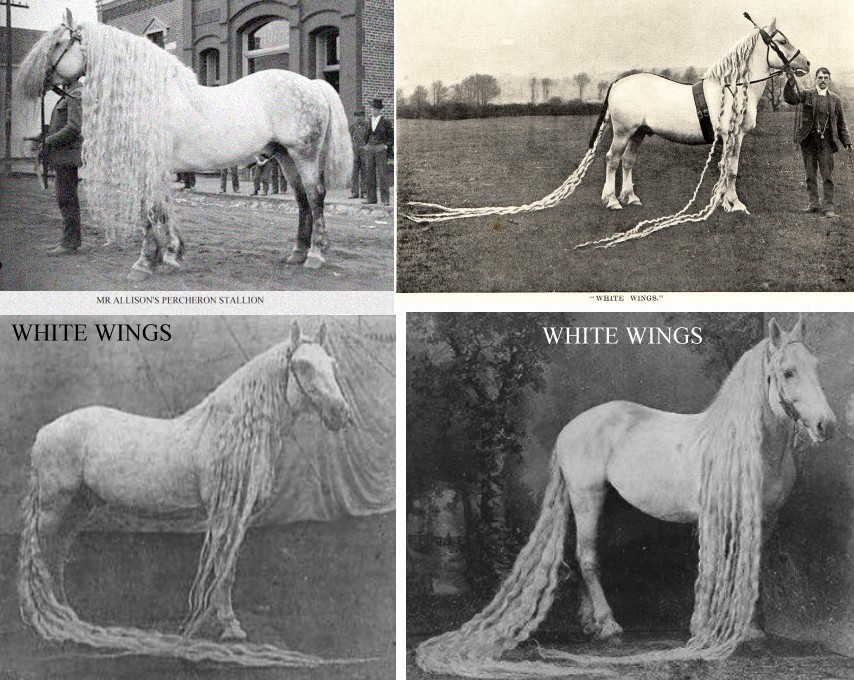
Circuses and sideshows often invented exotic stories about their exhibits. For example, exceptionally hirsute men were exhibited as "lion-faced men" or "wild men" along with tales that they had been captured in a remote country, were wild and ate raw meat. Despite the legends that the "Oregon Wonder Horses" had been captured from a legendary wild herd, they appear to have been bred from Clydesdale, Percheron draft horses, possibly with some Andalusian blood as well. Excessively long manes and tails would have been a severe hindrance in the wild and needed a lot of care in a domestic situation.
One of the earliest long-maned horses was a Percheron named "Prince Imperial" who also laid claim to the world's longest mane. Prince Imperial originally belonged to Emperor Charles Louis Napoleon Bonaparte III (nephew of the famous Napoleon). In 1806, Napoleon I had set up depots across France to breed cavalry horses. The most famous depot was "Haras du Pin" is Normandy. Norman (forerunners of Percheron) mares, which would have had rather mixed blood, were crossed with English thoroughbreds to produce good cavalry horses (the Percheron "breed", as we know it today, did not come about until after WWI when horses were brought back from France). Prince Imperial was a product of these breeding depots. Prince Imperial was born in 1865. In 1868/9, a Marion livestock breeder named Jacob Howser traveled to France and bought the horse for $3,000. Howser was a partner in The Marion Stock Importing Company and traveled regularly to Europe to buy stock to improve local bloodlines. Prince Imperial became the family pet of the Howsers and was exhibited at fairs and horse shows around the USA and billed him as "The Greatest Living Curiosity of This or Any Other Age". Prince Imperial was credited with having the longest forelock (at 7 ft) and longest mane (at 9 ft 10 inches) in the world, the mane later being described as 14 ft 3 inches at its longest. He weighed 1840 pounds and is believed to have been one of the first Percherons imported into the USA. When not being exhibited, his mane was braided and the braids looped to stop the hair dragging on the ground. Prince Imperial died in 1888, but continued to be a curiosity and money-spinner for his owner. When he died, his body was packed in ice and sent by rail to Rochester, New York. There, Professor A.G. Ward of the Ward Scientific Company made him into a taxidermy mount (pun not intended) which was kept in the parlor of the Howser home. Outside of the sideshow travelling season, the stuffed horse was kept in Howser's living room. After Jacob Howser died, his sons continued to exhibit Prince Imperial. This tradition continued to the next generation, with Jacob Howser's grandsons and great-grandson Jake Howser doing the same. Great-gradson Jake Howser tried to end the tradition and instructed his sons to burn the stuffed horse when Jake died. Luckily for sideshow historians, Prince Imperial was sold to another local family. They cleaned him up and put him on a wheeled platform which they dragged through local parades. He later became the property of Theodore Myers, associate director of the Marion campus of Ohio State University and member of the board of the local historical society. Myers kept Prince Imperial in a travelling case in his barn.
Prince Imperial eventually became the property of the Marion County Historical Society and continues to enjoy a degree of posthumous fame as a static exhibit in Marion, Ohio. at the Heritage Hall. For museum display purposes, Prince Imperial's mane now hangs on the wrong side.

White Wings was a pure white Percheron stallion whose mane was said to be 14 feet long with a tail 17 feet long. A 1902 book of animal life described White Wings as the most beautiful horse alive. He was exhibited by Bostock and Wombwell in their Royal No 1 Menagerie in England. According to Edward Henry Bostock ("Menageries Circuses and Theatres") "Unfortunately White Wing's tail had been cut off by a revengeful groom while the animal was in America, and this had to be plaited on and doctored up for show purposes. But for this defect I might not have been able to acquire the animal.
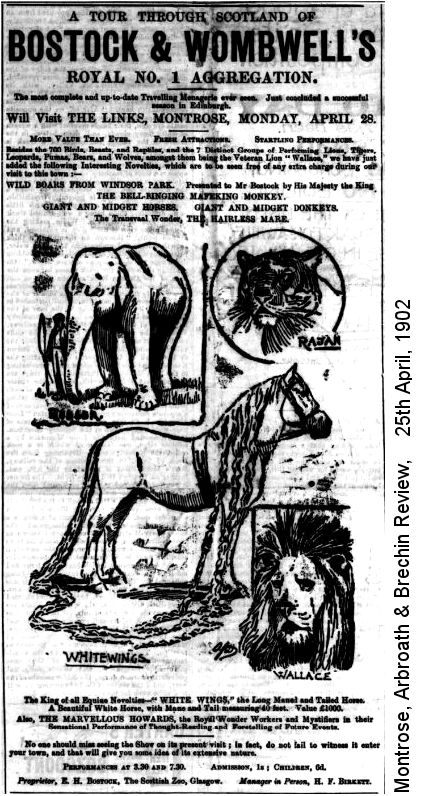 |
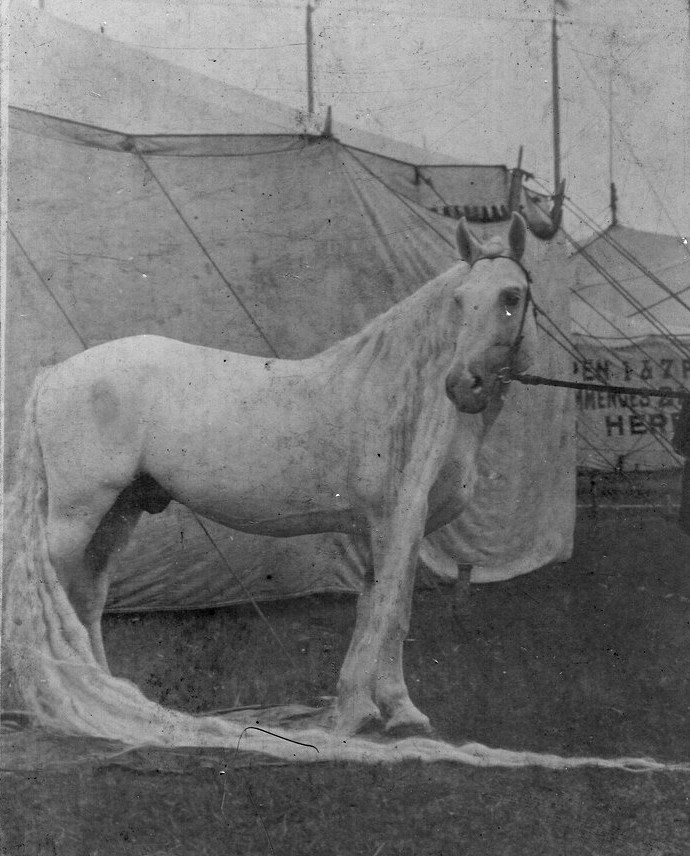 |
Below: White Wings, or one of the other white "wonder horses". I've converted the sepia image to black-and-white to improve the image.
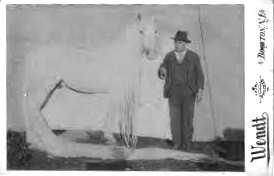
The horses for which we have the best "career records", however, are Linus and Linus II.
Books and magazines contain photos of 3 different horses, with different facial markings and different length white socks, all of whom claim to be the famous Linus. According to one postcard ("famous Oregon exhibition horse"), Linus' mane was 14 feet long (with 10 feet forelock) and his tail was 12 feet 3 inches. Another source gives his mane as 18 feet and the tail 21 feet. Other photos supposedly of "Linus" appear in the the 1902 book "Animal Life". These photos are actually his son Linus II and a similar, but unidentified, horse that might be either Aurelius (a brother of Linus II) or Montezuma (a possible son of Oregon Beauty). "Animal Life" (1902) claims a tail 17 ft long and a 13 ft double mane (circuses and sideshows are well known for exaggeration). One of these was Linus II who, at 8 years old, had a mane 13 foot long (with 5 ft 6 inch forelock) and a tail 19 foot long. At 11 years old, both measurements had decreased by 18 inches: mane 11 foot 6 inches; tail 17 foot 6 inches.
Many of the photos of the various Linuses are cabinet cards showing the attractions of circuses and travelling freak shows. There was also a promotional leaflet produced with a fanciful legend about Linus's ancestry which reads like a prequel to the My Friend Flicka/Thunderhead/Green Grass of Wyoming saga. This leaflet mentions Linus and Linus II. There are photos here of Linus I and Linus II and of a third "Linus" - undoubtedly related, but with different facial markings. The legend used to attract the public is as follows:
The story of the long haired Oregon horses
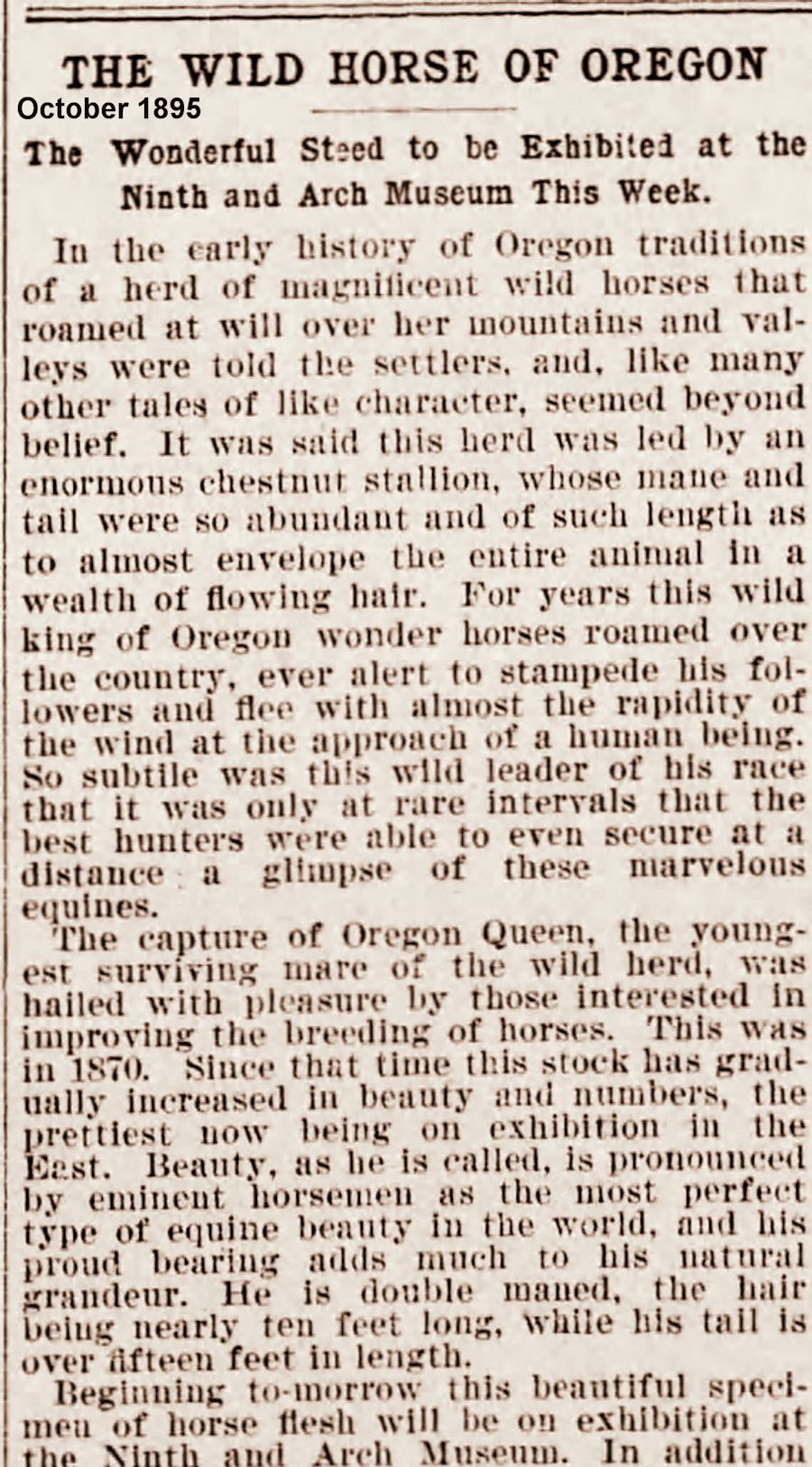
"In the early history of Oregon traditions of a herd of magnificent wild horses that roamed at will over her mountains and valleys were told the settlers, and, like many other tales of like character, seemed beyond belief. It was said this herd was led by an enormous chestnut stallion, whose mane and tail were so abundant and of such length as to almost envelop the entire animal in a wealth of flowing hair. For years this" Wild King of Oregon Wonder Horses" roamed over the country, ever alert to stampede his followers and flee with almost the rapidity of the wind at the approach of a human being. So subtile was this wild leader of his race that it was only at rare intervals that the best hunters were able to even secure at a distance a glimpse of these marvelous equines. Frequent hunts were inaugurated by those who had heard of the surpassing beauty of these horses for the purpose of capturing them to be placed in subjection and used for improving the breeding of the settlers' horses; but, though all the advantage that the intelligent hunter could command was brought to bear, added to which were large rewards for the capture of the magnificent leader, or some representative member of the herd, for years the intuitive cunning of this remarkably intelligent horse rendered his capture, or that of his followers, impossible, though for some unaccountable reason there was no apparent increase in the herd, which was later accounted for, as this wild king would brook no rival, and killed every male born to his equine harem.
Surrounded by his bevy of beautiful mares, who, like him, possessed in a marked degree the hirsute adornments that caused the settlers to seek their capture, this" uncrowned king" of the Pacific Slope continued to evade civilization until his demise, leaving sixteen beautiful mares to mourn their lifelong protector, but with apparently no means of perpetuating the race. Many, in fact most, of these mares were aged, for they, too, had followed the footsteps of their leader and fought among themselves for supremacy to such an extent that only such rivals as were imbued by nature with extraordinary powers of endurance were enabled to rear their female young; and possibly none would have survived but for the probable interference of the "wild old king," who saw in this bitter war of extermination the loss of opportunity to surround himself with the choicest of equine beauty, and so in a few instances must have insisted on allowing some "to live. At all events, of the sixteen mares but one was ever captured that was possible to breed, and she possessed extraordinary powers for perpetuating the peculiarities of her race, for, as shown in the second, third and fourth descent, all the leading characteristics of this marvelous mare are not only found, but in each instance strengthened and increased by careful breeding, so that now the "Oregon Wonder Horses" have become in captivity what they were in their wild state, a distinct and beautiful breed, exhibiting to a high degree the intelligence that enabled them to retain their liberty for so many years while pursued and eagerly hunted by the most famed scouts, cowboys and hunters the great West could command.
The capture of "Oregon Queen," the youngest surviving mare of the wild herd, was hailed with pleasure by those interested in improving the breeding of horses, both in Oregon and the entire Pacific Coast (for their fame was widespread), and when it became known that the "Queen" was to bear a foal by the old leader of the herd, offers of fabulously large amounts were made in advance of its birth for the offspring; but all were refused by Messrs. Rutherford, who had, by early purchase from the captors, secured the much-coveted prize. In the early spring of 1870 "Oregon Queen" became the dam of "Oregon Beauty," the first of the Wonder Horses born in captivity. This filly was treated with the utmost care, and soon developed into a marvel of beauty (hence her name); and when five years old, and after the birth of her first colt (Linus), was placed on exhibition, and proved one of the greatest drawing cards for fairs and museums ever known, until her death at Coney Island, where she was killed by lightning in the summer of 1888. Happily Linus, her son, who not only resembled his dam, but possessed even a greater development of tail and mane, was able to succeed her as one of the most attractive exhibition animals ever placed before the public."
The Sun, June 17th, 1888: “Oregon Beauty Killed By Lightning.” During the storm of Friday night, lightning struck the stable of H.C. moral, at Brighton place, Coney Island, and killed the valuable show mare, Oregon beauty. She was owned by M. D. Reed of an Francisco. She was a chestnut sorrel, 16 hands high, and had a white mane 9 feet 8 inches long. Her tail, which swept the ground, was also perfectly white. She was 8 years old, and had made the circuit of the principal towns of California. She was shown to Mrs. Cleveland, who admired her greatly. Two weeks ago, she was taken to Coney Island. Mr. Reed says he has refused $15,000 for her. In the stall next to Oregon beauty, a horse which had been purchased a day or two before for $5 was uninjured. Mr. Reed had no insurance on the mare.” More information appeared in The Times Democrat of 21st June, 1888: “On the same night a barn owned by H.C. Morse, at Brighton Place, Coney Island, was struck by a flash of lightning and set on fire. The bolt entered the barn at a corner of the roof, which was charred, travelled downward, splitting a pitchfork in pieces, and, before entering the ground killed a mare valued at $15,000. The animal belonged to M.D. Reid of San Francisco, who had been Mr. Morse’s guest for a few weeks. Mr. Reid came East at an expense of several hundred dollars to show the animal at Coney Island and in that district. She was a cross between a Clydesdale and French Canadian, dark chestnut in color, with a white mane and tail, the mane being four feet nine inches in length, and the tail sweeping the ground.” The Albany Daily Democrat of September 1st, 1888 then proclaimed “Oregon Beauty for Sale. The current number of the New York Clipper, contains and advertisement for the sale or lease of the famous mare, Oregon Beauty, which was killed by lightning on Coney Island on June 15th last, and which has since been mounted for exhibition. The proprietor, M.D. reed, states that her value before her decease was $20,000, but he does not say home much he wants for her now. The mane of the Beauty is now claimed to be ten feet in length.”
There were similar "wonder horses" in northern parts of Canada in the early 20th century. These could have been the “French Canadian” horses in the Oregon Beauty's ancestry. There are pictures in St. Walburg Museum, in the town of St Walburg, Saskatchewan, Canada.
Linus was sold in 1890 to Messrs. Eaton Brothers, of Boston, for $30,000, and proved a splendid paying exhibition property for several years, so much so that $60,000 was refused for him by his owners, who retained possession of him until his death in 1894. In the meantime, by careful and judicious breeding extending over a period of twenty-five years from the capture of the first mare, the Messrs. Rutherford have succeeded in establishing this breed of "Wonder Horses" on a secure foundation; and, though guarding with utmost jealousy all the progeny, they carefully continued their line of breeding until they possess to-day absolute control of a distinct breed of horses, the like of which has never been seen in all the world, nor will it ever be reproduced, since the wild origin is now extinct.
The" Wonder Horses" of Oregon are remarkable for the great growth of hair in mane and tail, which for length and thickness is not equaled in the world; and since these horses have been bred in captivity this growth of beautiful silken hair has increased with each generation, as will be seen from a comparison of the photographs contained herein. The wonderful endurance and intelligence of this breed of equines is at once apparent to anyone familiar with horses; and now that all trace of the wild nature has bowed to the gentle care and treatment meted out to these animals, they exhibit the utmost gentleness and court the attention of those who come near them. Another remarkable characteristic of this truly wonderful breed of horses is their color, all of them being rich chestnuts, which goes far to prove them a distinct breed, able, by reason of their thoroughbred origin, to perpetuate their blood from generation to generation.' No doubt the "Oregon Wonder Horses" are the truest descendents of the first horses brought to America by Cortez, the conquerer of Mexico. Probably some escaped at that early period and established this breed hundreds of years ago remaining wild and uncaptured.
Linus II is pronounced by eminent horsemen as the most perfect type of equine beauty in the world, and his proud bearing adds much to his natural grandeur, for he carries himself as a worthy successor of his wild old ancestor, the King of Oregon Wonder Horses, in whose place he now stands as leader of his race."

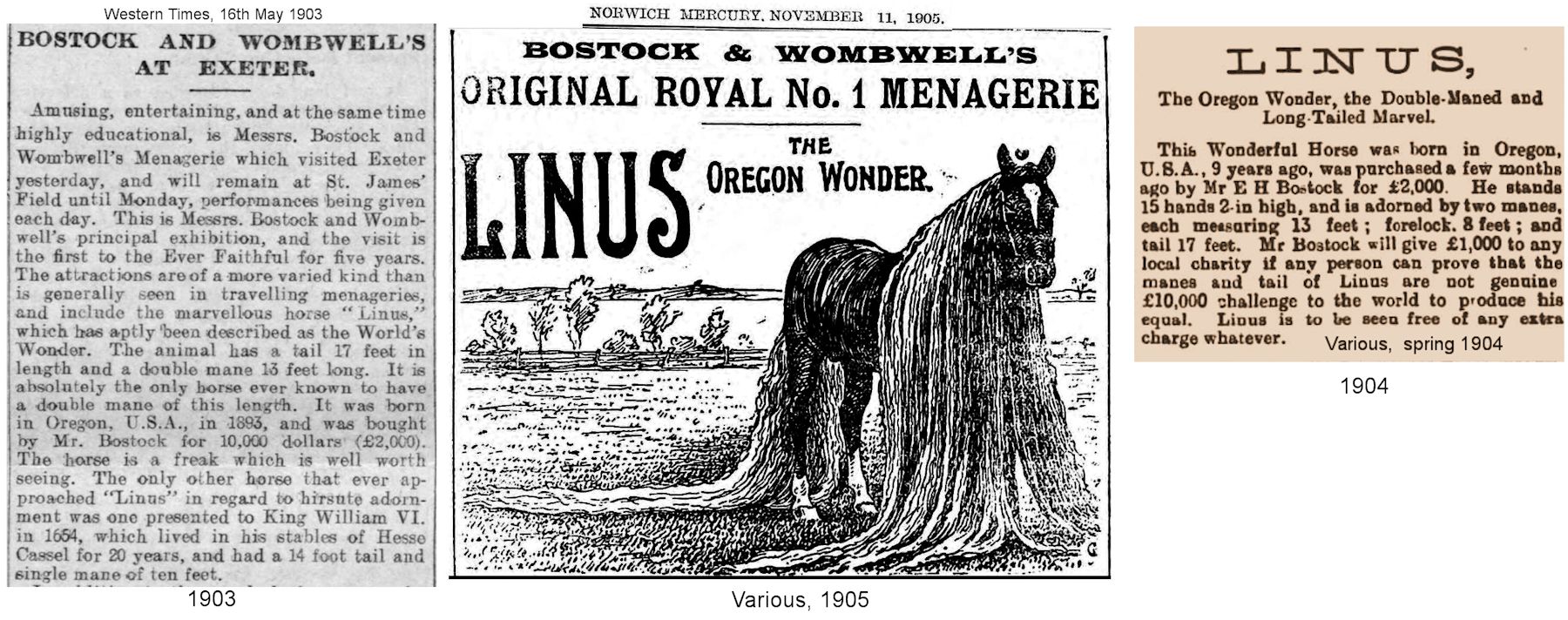
The true origins of the Oregon Wonder Horses is more mundane. According to a report in the New Zealand Observer "The first of these long-maned Oregon Wonders came to light in the [eighteen-]eighties, being worked on a farm in Oregon. He was then taken East and put on exhibition, dying in Coney Island in 1887. His son Linus was the only colt sired by him of which there is a record that he had the same superabundance of hirsute [hair] and Linus II was likewise the only one of the sort got by his sire." That farm horse was actually a mare named Oregon Beauty, who produced a son, Linus, in 1884. Oregon Beauty was indeed exhibited and the New York Times reported that she was killed in a fire on June 17, 1888 at Coney Island (a popular exhibition venue) when "Lightning struck the gable of a roof and glancing off, set a heap of rubbish on fire 10 feet away. It then went through the stable, setting it on fire and killing a very fine mare belonging to M.E. Reid of California. The animal was the celebrated Oregon Beauty, a beautiful dark chestnut, 9 years old. She possessed a fine, large, bushy tail and a heavy mane 10 feet long. She was valued at $15,000. She was well known throughout California and Oregon, having been exhibited in all cities and towns of those states, and her owner had brought her to New York to exhibit to the admirers of horse flesh."
This original Linus is known to have been three-quarter Clydesdale and one-quarter French (Percheron) and his weight was advertised as 1435 lbs. He was bred in Marion, Oregon, about 1884, then acquired around 1890/91 by brothers CH & HW Eaton from Calais, Maine. Linus was sold to the Eaton Brothers for $30,000 in 1890, but died in 1894 at the age of 10 years. By then, he had sired Aurelius (born Oregon June 1890) and Linus II (born 1894). Aurelius was exhibited at the Egyptian Theatre in Los Angeles as one of the "Oregon Wonder Horses" and was 16 hands tall with "a luxuriant mane and tail". Some photos of Linus II can also be found labelled as being Aurelius (mane 7 ft, tail 8 ft) who was two-thirds owned by LA Cole and JK Rutherford. According to the Daily Capital Journal, September 19th, 1894 “W.A. Rutherford of Marion exhibits Aurelius, by Oregon Wonder. He has a seal brown mane 5 and a half ft, the tail eight ft. He is four years old and surpasses any horse on earth in this respect.” (State Fair Notices)
The Eatons became the most successful promoters of the horse. "When about four years old his mane and tail grew so rapidly-often as much as 3 inches a month -that in three years they reached their present astonishing length. His body colour is a glossy golden chestnut, he has white hind feet and a white face, and his mane, tail and foretop are of a soft flaxen colour. His hair, which is 'done up' when he is not receiving visitors, continues to grow, though now very slowly. Linus is certainly a beautiful animal. He is proud, carries his head high, and enjoys admiration with all the intelligence and pride of his race. The mane is 14ft, the foretop 9ft and the tail 12ft. When spread and drawn out to their full extent, the display of the beautiful locks is quite impressive. It is washed out with cold water, no tonics being applied to it. Before the horse is placed in his stall the hair is drawn out and divided into several thick strands. From his mane four such strands are made. Each strand is then tied around once every six inches almost to the end. It is then rolled up and put into a bag. For his mane and foretop alone five bags are required. He is exercised in the same guise, a blanket or sheet, if necessary, being thrown over him to conceal the pendant bags. He is exercised every day, either in a ring or out of doors under saddle. The owners will not permit him to be taken into the upper floor of any building for fear of some accident."
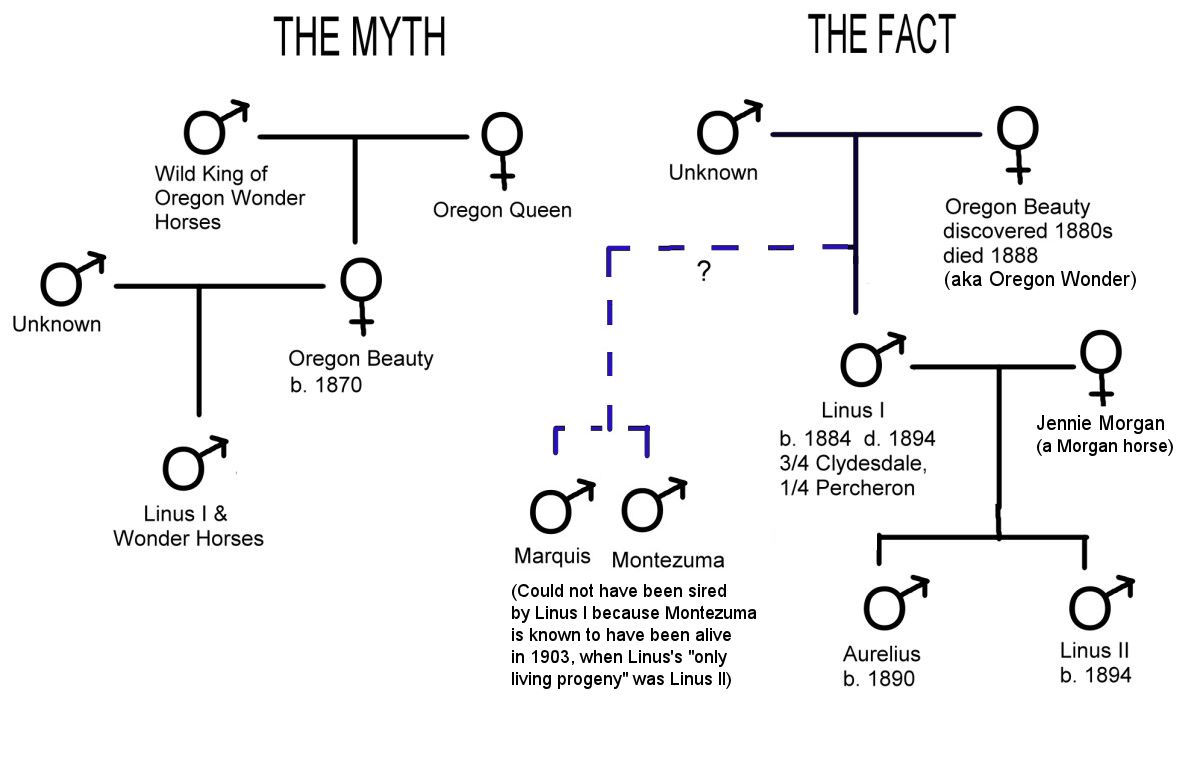
Linus was featured in Scientific American in 1891 where he was described (incorrectly) as a Percheron stallion (Percherons are grey, Linus was chestnut): "He is 16 hands in height, weighs 1,435 pounds and is of chestnut color. The mane is fourteen feet, the foretop nine feet, and tail twelve feet long. When spread and drawn out to their full extent, the display of the beautiful locks of bright hair is quite impressive. The greatest care is taken of the hair. It is washed out with cold water, no tonics being applied to it. Before the horse is placed in his stall the hair is drawn out and divided into several thick strands. From his mane four such strands are made. Each strand is then tied around once every six inches about to the end. It is then rolled up and put into a bag. For his mane and foretop alone five bags are required....During the last two years his mane and tail have grown about two feet."
The Cincinnati Enquirer of November 29th, 1902 had a nice description of Linus II, along with a photograph credited to the New York Herald: “Oregon’s Freak Horse. Linus II has a tail nineteen feet long – mane measures thirteen feet. On board the Atlantic transport liner Minneapolis, which sailed Saturday from New York, was the last of the Oregon wonder horses, Linus II, bounded for London. Linus II is shipped in the name of Frank C. Bostock to the Bostock Syndicate of London, Glasgow and Paris, for the London Hippodrome. Mr Bostock a few days ago paid a large sum, said to be $15,000, to Rutherford Bros & Coe, of Waddington N.Y. for the animal and sends him across the water insured in several companies for a total of $40,000, in charge of his trainer Silas Beebe. Linus II, eight years old, is a rich chestnut with an amber mane and tail. His mane on each side is a little more than 13 feet long, while his tail measures 19 feet. It takes two hours to properly groom him. His mane and tail are each tied up in many separate folds, the mane being many times the thickness of that of an ordinary horse. It is expected that he will create a sensation on the other side of the water. The first of this breed of horses was Oregon Beauty, a freak foaled in Oregon. His only progeny was Linus, whose only living descendant is Linus II, out of the Morgan mare, Morgan Jennie. A peculiar fact in regard to these three generations is that in each, the length of the mane and tails increased. Oregon Beauty was worked on a farm until 13 years old, before being put on exhibition, and in 1887 at Coney Island, he was killed by lightning. Linus, sire of Linus II, died in 1894 at Calais, Maine. Oregon Beauty, as we know, was a "she" not a "he!" It also notes that Linus's only living progreny was Linus II, which means that Aurelius had already died and it gives us the name of Linus's mate - Jenny Morgan.

The sideshow business was highly competitive and as well as Linus, there were several other Wonder Horses. "Santa Rosa, California has the distinction of being the home of one of the remarkable horses of the age. It is Montezuma, a son of Oregon Wonder, the long-tailed and long-maned curiosity of the Nortwest. This horse has a handsome tail over six feet long, and its mane is over five feet long." ("Horses and Horsemen. Notes from the Carriage Room, Auction Mart, and Breeding Farm" New York Times Jan 1st, 1894.) While Oregon Wonder might be another name for Oregon Beauty, it is equally likely that a competing sideshow invented the name so that the horse appeared to be a relative of the famous Linus!
La Grande Observer, March 30th, 1902: “Montezuma, the Oregon Wonder, Jr. Bearing the longest mane and tail of any horse in the world. This horse will be in La Grande on April 14th, and you must not lose the opportunity of seeing this wonderful beauty.” On July 16th, 1903, the same publication wrote, “Montezuma, the big sorrel stallion, with an extraordinary long mane an tail, was purchased at sheriff’s sale the other day by Turner Oliver for $250,” which suggests that the horse had been seized from his previous owner.
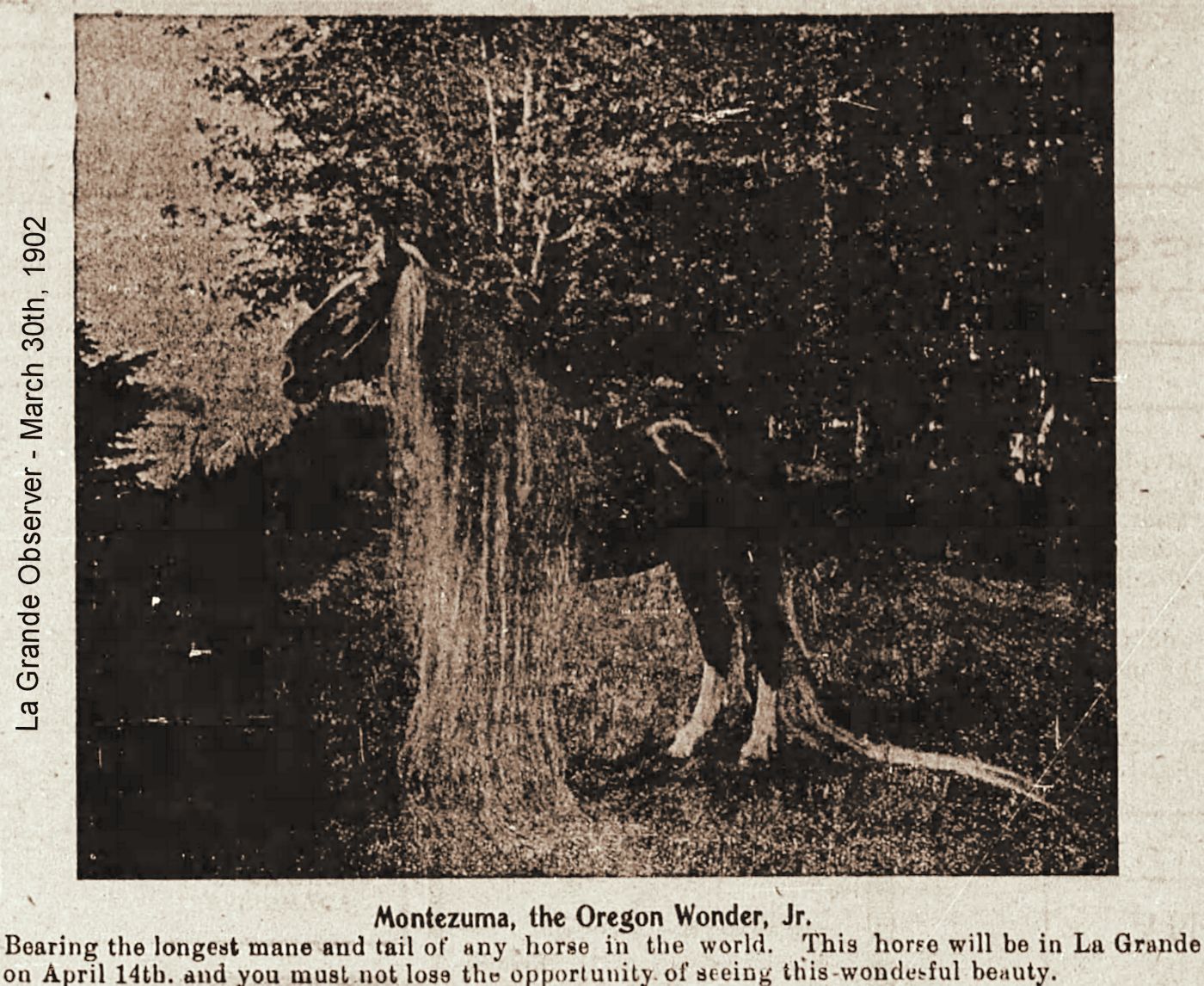
A Wonder Horse exhibited at Fells Waxworks in Glasgow, Scotland was very similiar in appearance to Linus and Linus II, suggesting he was a son or brother of Linus. Marquis was another three-quarter Clydesdale and one-quarter French, at age 7 his mane was 14 ft and his tail was 18 ft long. Marquis was bred at Grande Island, California and owned and exhibited by J A Grimmer and J O Sharp. In 1894, Ringling Bros boasted of exhibiting Prince Chaldean, the long-maned Percheron, with a mane over nine feet long. Various papers in 1892 ran this press release for Ringling Bros circus: “ THE PERCHERON BEAUTY. A Horse With A Mane Nine Feet In Length With The Ringling Bros. ‘ Prince Chaldean, the Percheron Beauty’ is the name that has been appropriately bestowed upon one of the most beautiful specimens of the equine that nature has ever produced, and which through the enterprise of the Ringling Brothers has now for the first time been placed on exhibition. This wonderful horse is worth a day’s travel to behold. One cannot conceive anything more beautiful in horse flesh. Picture the finest and heaviest Percheron ever imported, give him a lordly mien and a noble carriage, inspire him with the pride of an irreproachable pedigree, and crowning all, imagine such a horse with a mane so long that despite his great height it sweeps the ground, and that will be a mild drawing of this marvel among equines. Prince Chaldean’s mane by actual measurement is nine feet two inches in length, and his tail is correspondingly long. His weight is over 1800 pounds. He was sired in Eure et Loir, Normandy, and is registered as No 854 and 637. Nothing like this noble animal has hitherto been seen in America, and as one of he novel features of the Ringling Brothers’ World’s greatest Shows he has created a sensation. This famous horse, with a thousand other novel things, will be seen with the Ringling Brothers’ mammoth tented exhibition. [insert date and venue here!]”
Bostock and Wombwell had White Wings, claimed to be the most beautiful horse alive and said to be of Spanish Andalusian descent. Another long-maned horse was Jack Allison's Percheron, photographed circa 1880. The Walter L Main Circus boasted a white long-maned horse "Boneito". It appears that the chestnut Oregon Wonder Horses (including Linus I, Linus II, Marquis) were Clydesdale/French (Percheron) mixes while the white ones were Percherons or Percheron/Andalusian mixes. One article erroneously described Linus as a Percheron, rather than a mix.
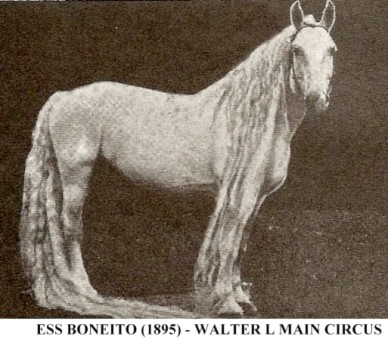
If a sideshow couldn't get hold of a living Wonder Horse, then a taxidermy specimen would suffice. The stuffed Prince Imperial had a long posthumous career. A stuffed Wonder Horse was exhibited in San Francisco and advertised in a brochure for Chutes Museum (which opened in 1897): "Here may be seen the $3,000, long-tailed and long-maned horse, "Beauty". This animal, in life, was one of the chief attractions of the zoo. In death, he is a permanent interest not alone to those who knew him in the zoo, but to those who now see him for the first time. A more beautiful animal never lived." Despite the name, this was not Oregon Beauty as she was female (the taxidermy was male) and had been killed in a fire (which would have consumed her mane and tail), but is more likely to have been Howser's well-travelled French import, Prince Imperial.

An account of Linus II, son of Linus, appeared in 1899 and detailed the amount of care required to maintain the mane and tail - this immediately rules out any idea of there being a wild race of "wonder horses":
"A WONDERFUL HORSE. The Sampson Among Equines. Lawrence D Fogo.
The accompanying illustration pictures the most wonderful horse in the world - Linus II, son of Linus, a celebrated horse in his day. That his owner James K Rutherford, of Waddington, NY, is very proud of him goes without saying. No photograph can do adequate justice to his superb beauty. In colour he is of a golden chestnut, with a coat like satin. His wonderful mane is double, falling in a solid mass down both sides of his neck and lying about four feet on the ground. In color the mane is much lighter than the horse's body, and mixed with white, very fine and silky, so that it gives a silvery appearance.The tail is even more remarkable than the mane, measuring over sixteen feet from tip to tip, and lying on the ground fully nine feet. It is white, with a dark streak showing in the center. The abnormal growth shows not the slightest tendency to stop. The photograph herewith was taken a year ago. During the short time which has elapsed since then, both mane and tail have made a growth of eighteen inches.
The most painstaking care is taken of Linus II. When not on exhibition, his hair is treated in the following manner: The mane is parted evenly down the back of his neck, and each side divided into five parts. Each part is then braided, beginning about six inches from the neck. After braiding to the end of the hair, it is doubled up and passed through to where the braid began, making a loop about ten inches long. This is repeated until the braid is all looped up, when it is tied and a bag, made especially for this purpose, is drawn over it and securely fastened. The foretop and tail are cared for in a like manner, and thus he has perfect freedom in his movements.
Just because of this wonderful growth of hair, Linus has been facetiously dubbed the Sampson of equines, a name that is not wholly applicable, because he has displayed no remarkable feats of strength, though not wanting in powers of endurance for a horse of his size and age. Linus is a large horse, standing nearly sixteen hands high, and weighing 1,300 pounds. He is nine years of age and enjoys perfect health. The noble animal is high spirited, but withal gentle and affectionate, and has become greatly attached to his groom. He has an excellent memory. mr Rutherford's partner, who formerly had the care of the horse, taught him several tricks, for the successful performance of which the animal received candy and apples. Upon his going into the horse's stall, after not seeing his master for three years, Linus immediately recognised him, and began to perform the tricks that had been taught him, and which the horse had not done once during those three years.

Linus II was widely exhibited in the USA including star turns at the American Horse Exchange (Broadway, New York) and Huber's Museum (New York). He also took parts in harness parades and was also ridden. In 1903, or thereabouts, he travelled to the UK and was exhibited in England, Scotland and Ireland. One photo taken during Linus II's tour describes him as "the famous Linus II of Killarney". At that time, travelling animals shows were a major form of entertainment and travelled throughout North America, Britain, Continental Europe, South Africa, Australia and New Zealand. During 1905, Linus II was purchased by Bostock and Wombwell for £1200 (though £2000 is also claimed). Linus II replaced their white Perchereon stallion, White Wings, in their Royal No 1 Menagerie in England. EH Bostock wrote: "Another freak of this kind procured for me after many futile attempts was a horse named Linus [Linus II]. This was a horse, chestnut coloured entire [i.e. not gelded], which, while not so large as White Wings, had two distinct manes, one on each side of his neck. Its tail measured 16 feet and was also prolific of hair. Linus cost me £1,200 - four times more than I paid for White Wings - but its drawing powers did not come up to expectations. The reason for this was that the novelty had worn off. White Wings had already been all round the country, and the public were ready for a fresh freak. Linus and White Wings, however, were both animals of which one could well feel proud." In March 1905, Bostock and Wombwell's Menagerie ("Britain's premier travelling zoo") was in the Common Haugh, Hawick, Scotland for two days before travelling to Selkirk and Jedburgh. Entrance to one of the three daily performances cost 1 shilling (adults) or sixpence (children) and the star of the show was Linus [Linus II] even though he was not a performing horse. He was billed as having a double mane reaching 13 feet each side and a 17 feet long tail. It was reported that he had been bought two years earlier for £2000 and the proprietors offered to forfeit £10,000 if his equal could be produced or give £1000 to any local charity if any person could prove that the manes and tail were not genuine.
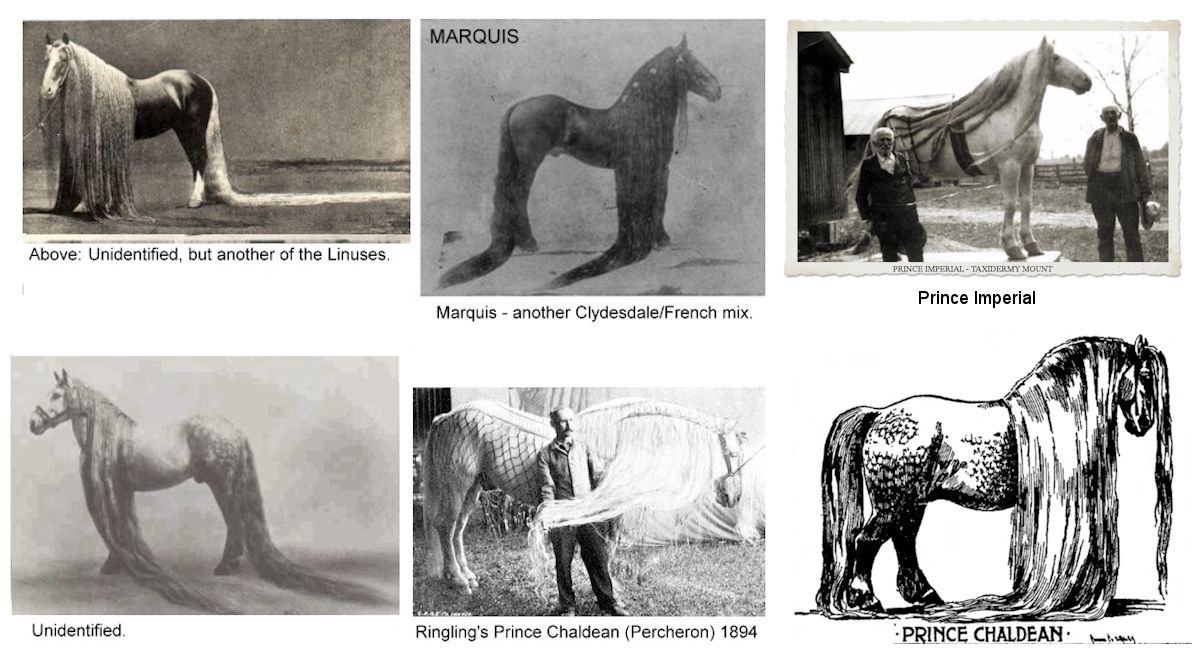
After extensive tours of America and Britain, Linus II joined the Bostock and Wombwell menagerie in Australia where he was supposed to join their tour of Queensland. This had to be cancelled due to a tick plague in Queensland that would have resulted in the animals being quarantined for six months after the tour. The Queensland leg of the tour was cancelled and menagerie headed back to Sydney and Melbourne. Linus II was billed as one of the star attractions when exhibited at Fitzgerald's Circus Building, St Kilda Road in Melbourne in October 1906 where the exhibition formed part of the Caulfield/Melbourne Cup Carnival. The Argus (Oct 18, 1906) reported: "Among the attractions of Bostock and Wombwell's Circus, which opens at Fitzgerald's Circus building on Saturday next [this was on Caulfield Cup night], are several specimens of livestock, which differ from the class of animals usually to be seen in a menagerie. Chief among these is Linus, a fine bay stallion, whose points of pride are his beautiful mane and tail. Two days off the boat, on board of which he has spent 41 days, Linus, in excellent condition, awaits inspection, surrounded by the plenitude of his hair. His tail lies along the ground for several feet and the drooping flood of his double mane covers the canvas on which he stands. Although his broad back and heavy shoulders show traces of draught blood, his alert poise and cocked ears betray his trotting strain which is transmitted from his mother. He has been exhibited all over England and America. Two friends of Linus are a fine pair of Harlequin danes, fine upstanding dogs of the Great Dane breed."
Various newspapers in June 1904 printed this item, which was the start of heredity studied into long-maned horses. “Wonder Horses. Recent discussions on the laws of heredity in scientific journals refer to the ‘Oregon wonder horses,’ and equine family which was famous not many years ago, the last representative of which is said to have been exported to Europe a few months ago. One of these horses, known as Linus I, had at 14 years of age, a mane 18 feet long and a tail of 21 feet. A son of this horse, Linus II, which was owned at Waddington, N.Y., in 1899, had at about five years of age a double mane trailing two feet on the ground on each side. His tail trailed six or eight feet on the ground. The mother and the paternal grandmother of Linus II were also remarkable for the length and abundance of their hair. One of them was known as the ‘Oregon Beauty.’ These horses are said to have belonged to the Morgan breed.” [the last comment is incorrect, they were not pure Morgan horses]
Thomas Hunt Morgan (Professor of Experimental Zoology, Columbia University) mentions Linus I in his book Experimental Zoology (Publ. Macmillan & Co, London, 1910): A few other cases in mammals, that seem to show discontinuous inheritance, are known. Castle and Davenport [Professor C. B. Davenport, and by Professor C. E. Castle] have both called attention to cases of so-called wonder-horses, i.e. horses with remarkably long mane and tail. In the case of ''Linus I" the mane was 18 feet long and the tail 21 feet. The parents and grandparents of these horses also had unusually long hair, which increased in successive generations. The data are insufficient to show the relation of dominance and recessiveness in this case, but the persistence of the long hair seems to indicate its dominance. The mane and tail lengths are possibly exaggerations taken from promotional literature.
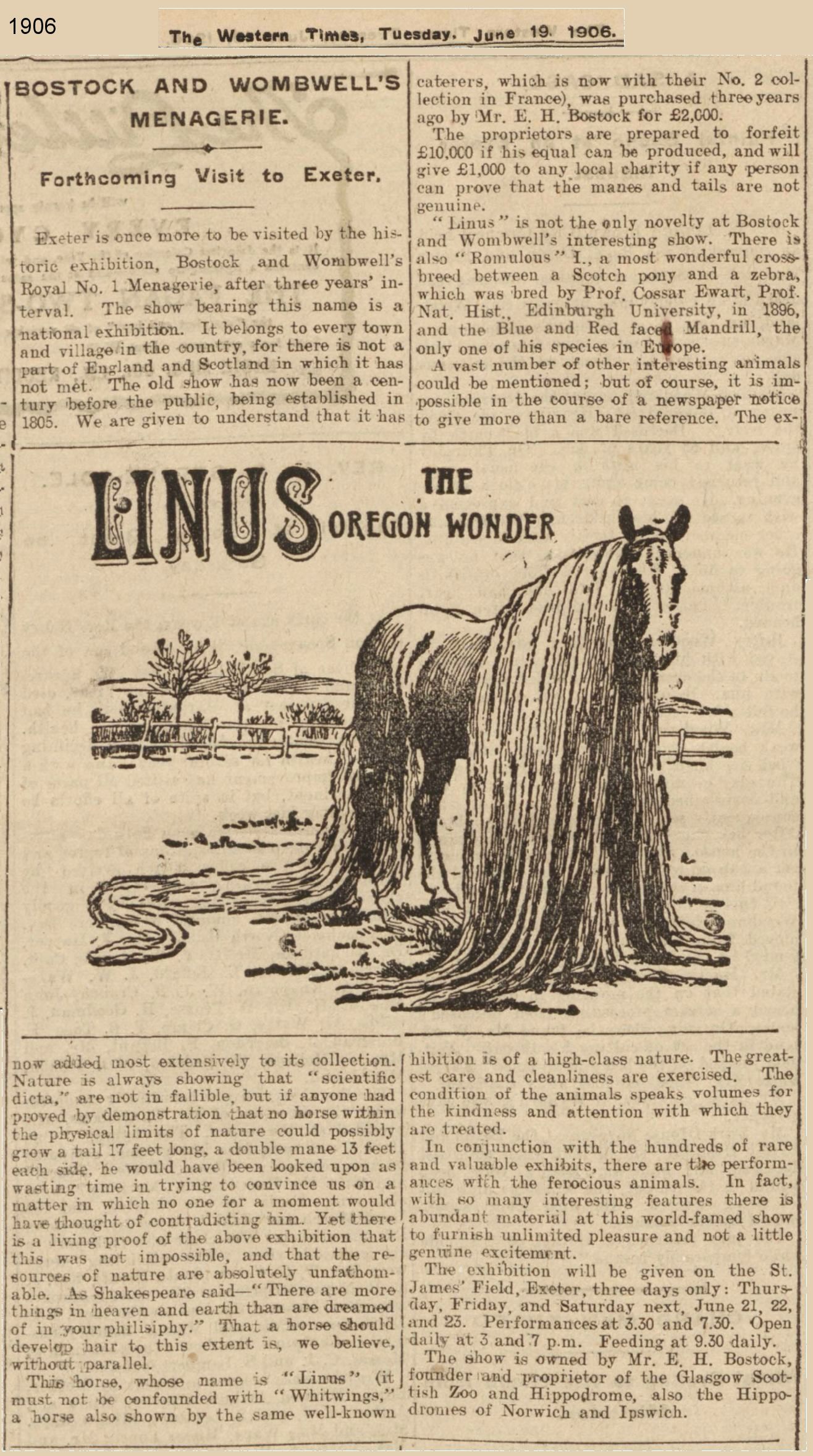 |
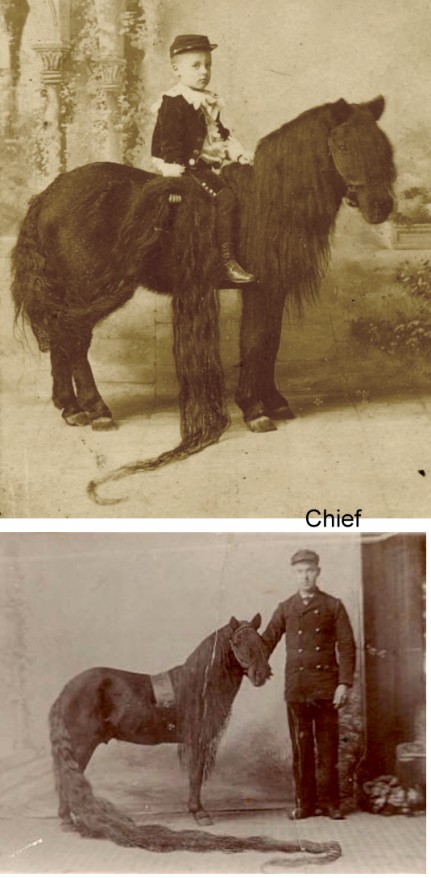 |
|
WONDER HORSES AND MENDELISM DR. CASTLE'S reference to the Oregon Wonder horse in SCIENCE for December 11 reminds me that in the autumn of 1899 I corresponded with Mr. James K. Rutherford, of Waddington, N. Y., who then owned a horse celled Linus II. Mr. Rutherford sent a photograph of the horse, taken in 1898. The photograph shows a Morgan horse probably about five years old with a double mane which trails on the ground on either side for a distance of two feet. The tail trails on the ground for a distance of about six to eight feet. Correspondence with Mr. Rutherford yielded the following additional statements: Linus II is the son of Linus I, which had a mane that was single, but at fourteen years old eighteen feet long, while the tail was twenty-one feet long. “The mother also had a remarkable growth of hair.” The paternal grandmother was known as the "Oregon Beauty" and was noted for the mass and length of her hair. My correspondence with the owner of Linus I led to few additional facts. He stated that the long hair had been in the family since importation [to Oregon] and added: "the growth and quantity has increased with each generation" It will be seen that the data are somewhat inconclusive. Had the father as well as the mother of Linus I been long-haired (recessive, according to Dr. Castle’s hypothesis), then we can understand the long hair of Linus I. The latter was mated with a recessive mare (if "remarkable growth of hair" may be so interpreted) and produced Linus II. On the whole, it would seem more probable that the long-haired property was dominant, unless, indeed, Linus II got no long-haired progeny. The data are, as we see, insufficient to decide the matter. [Davenport then goes on to illustrate Dominant and recessive Mendelian factors by discussing polydactylism .] |
LONG-TAILED PONIES
"Chief" the long-tailed pony: tail 13 feet long, height 3 and a half feet, weight 300 pounds. His exhibition equipments consists of fine blankets, brass exhibition stand and suspended tail rest, which gives the effect of tail floating in the air, and the satin sashes, banners and flags make up the most unique and beautiful equipments of any pony of horse travelling. He has travelled over the greater part of the United States and Canada and is engaged to go to Europe. He was in a railroad accident, in which there were seventeen cars wrecked, fifty horses, twelve men and many wild animals killed. In the car he was in there were four men and twelve horses killed, and as he was in between a camel and a water buffalo and a large elephant back of him it was a miracle he was not killed; but neither he nor his attendat, who is in the picture, was hurt except being pretty well shaken. Everyone admits he is a wonderful little horse and we challenge the world to produce his equal in beauty, intelligence, and size, with the length of tail.
The Cincinnati Enquirer, 13th November, 1893: One of the most valuable pieces of horseflesh in the country will be exhibited at Kohl & Middleton’s Dime Museum this week. The horse is not noted for his lineage of his speed, but for his tail and he is called “Chief, the Long-tailed Pony.” His tail is thirteen feet long and his mane touches the ground.
Altoona Tribune, 8th February, 1894: “ The chief attraction at the Harry Davis Eden Musee for the coming week may well be pronounced “Chief,” not only in the matter of name, but as regards its merits. “Chief,” the long-tailed pony. His tail is thirteen feet long; he is 3 and a half feet high and weighs only 300 pounds. There can be no question that he is the greatest equine curiosity in the world. He is gentle and tractable in disposition to that extent that he is quite unhappy if he is not constantly petted and fondled by the children.”
There were press releases and advertisements in various papers in February 1894: "Chief, the long Tailed Pony. The greatest equine curiosity in the world: the most beautiful and complete equipment of any pony ever exhibited; as gentle as a lamb, as playful as a kitten; tail 13 feet long, height 3 and one half feet, weight 300 pounds." Another press release went "Next Week At the Musee. Next week the many lovers of amusement of this city will be given a chance to witness the diminutive long-tailed pony, “Chief,” who is said to be the greatest equine curiosity in the world. This remarkable animal has a tail thirteen feet long, stands three and a-half feet high and weighs only 300 pounds. He is most beautiful to lock upon and is a great pet of the ladies and children." Other press releases from 1894 said "his mane is 12 feet 6 inches long and his tail is 15 feet long." From the Boston Post, 26th February, 1894: “Herr Blatt will be the sensation at Austin & Stone's this week, together with the long-tailed pony and many other novelties.”
Detroit Free press, 23rd June, 1896: "The Pony Chief Attracts the Children in the Curio Hall. Chief, the long-tailed pony, is exhibited at Wonderland this week in regal style. He stands within a highly polished brass railing with his beautiful black silky tail combed out nicely on a gilded exhibition board. Chief is only three and one-half feet high, but he is as perfectly formed as a blooded Kentucky runner. He is a great drawing card, and is especially a favorite of the little folks."
Alexandria Gazette, 12th January, 1897: “An Interesting Equine Exhibit. On account of the interest ladies take in a clever horse or one that is unusual in any marked degree, and for the pleasure of all who shall visit our store, we have secured and now have on exhibition “Chief,” The Long-tailed Pony. “CHIEF” is only forty inches high, weighs 300 pounds, is a beautiful jet black, but the greatest wonder is the length of his tail, which measures 45 feet [a misprint]. The trappings and equipment of this great equine curiosity are the most beautiful of any horse traveling. On exhibition all this week between the hours of 10 a. m. and 5 p. m.”
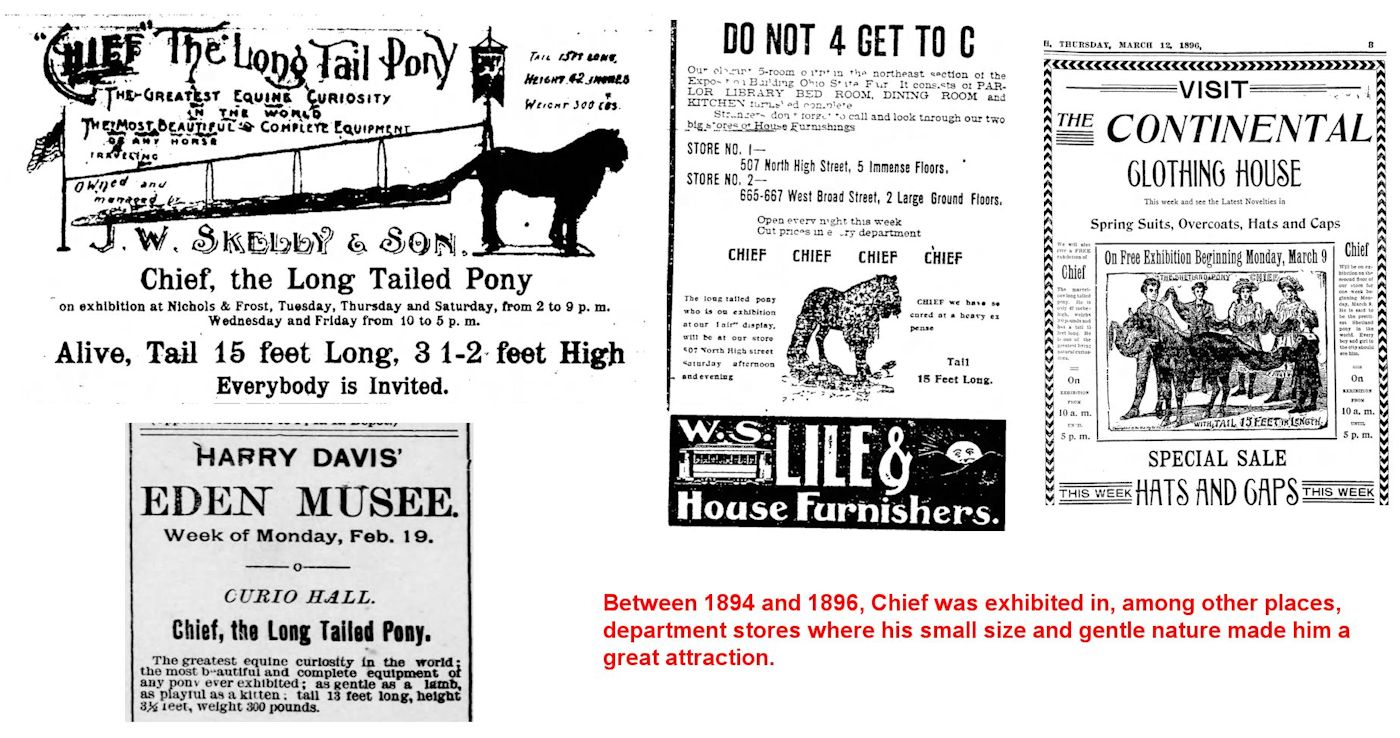
Another long-tailed pony became the subject of a court case alleging fakery. The details of the pony and the accusation appeared in several newspapers between 1905 and 1908.
"TOM TIT," a pony with a tail that is 13 feet 4 inches long, is the latest acquisition of the Bostock animal show at Coney Island. The equine is really a midget horse, a runt, in other words, as his parent» were full grown one and well bred animals. Their names were Queen Victoria and U. S. Grant. "Tom Tit"' was received by express from Indiana and immediately placed on exhibition, causing considerable interest. After being on exhibition here during July, the pony will be shipped to Europe and shown, first at the Bostock arena in Blackpool, London, and then at the Hippodrome, in Paris. (The Brooklyn Daily Eagle, July 2, 1905)
A DIMINUTIVE PONY pony multiplied by three times his length of his tail is the present wonder at the Bostock animal show at Coney island! Like all great unfolders of yarns, he hails from Indiana, whence he arrived by express Tuesday. His costume, which consisted of a bag carefully con¬cealing his hirsute beauty, was removed when he was placed on exhibition, and down rolled the tail, with the long drawn-out interest of a serial story. It measures thirteen feet four inches. Tom Tit, as he is called, doubtless inherits his liking for a court train length. His mother was Queen Victo¬ria, and the fact that U. S. Grant was his father seems to have little effect upon his monarchial tendencies. Both parents were of the ordinary size, and their midget son was as great a surprise to them as to his owner, a rich and eccentric old farmer. He kept little Tom Tit in seclusion and up to two months ago the pampered pony boasted not only his hairy extension, but a double mane ad a forelock eight feet long. A vandal broke into Tom Tit’s stall one night and cut mane and forelock to pieces. The purchase price for the pony was $25,000. (The Minneapolis Journal, September 9, 1905)
ALLEGES FAMOUS PONY WEARS SWITCH IN TAIL German Purchaser of Richmond Show Horse Sues Trainer Bostock for Fraud.
Richmond, Indiana, Aug 19. Tom Tit, the famous long-tailed pony once owned by Oliver Fouts of Richmond, has been declared to be the possessor of a false tail by the courts In Frankfurt, Germany. Tom Tit was sold by Mr. Fouts to Frank C. Bostock, the English animal trainer. Bostock, in turn, sold the animal to a German trainer named Paul Batty. The latter brought suit against Bostock on fraud charges, claiming the long tall of the pony was false. The German courts sustainud him and ordered damages to the extent of several hundred marks. Bostock will fight the decision. A letter was received form him today asking for local af¬fidavits. (The Indianapolis Star, August 20th, 1908)
TALE OF A PONY WITH A TWELVE FOOT TAIL. RICHMOND SHETLAND CALLED NATURE FAKE IN GERMANY. BOSTOCK APPEALS FOR AID
[Special to the Indianapolis News.]
The Indianapolis News, August 22, 1908
Though there is no fear that International complications will result from the controversy that has arisen over the length of the tail of a Richmond pony that has been exhibited in almost every country in the world and before the “crowned heads’ of many nations, it is certain that affidavits from citizens, pro and con, in at least three countries — America, England and Germany — will figure in the court proceedings now pending in Germany as a result of a most unusual suit for damages.
This "tale of a pony tail" which has caused the dignified courts in both England and Germany to sit up in surprise and has also caused bitter gnashing of teeth on the part of the world’s greatest animal broker, Frank C. Bostock, has its opening chapter in Richmond five or six years ago. Oliver C. Fouts, a life-long resident of Wayne county, who died three years ago, was throughout his long life a horse trainer, and during his career also had several Shetland ponies under his care which he "educated" for the ring. The field was not overly crowded, and Mr. Fouts found the occupation profitable, as every pony he graduated from his little white barn in the east end of Richmond found ready sale to circus owners.
Shetland ponies came and Shetland ponies left Mr. Fouts, but it was not until about eight years ago that he had for his protege a diminutive animal that not only displayed exceptional intelligence, but gave evidence of deep-seated vanity in the possession of mane and tail of exceptional luxuriance. The tall began to grow with such rapidity that Mr. Fouts was finally compelled to "do it up" in curl papers every night in order to keep it off the ground. Mr. Fouts finally decided that perhaps "Tom Tit," for that was the name bestowed on the pony, might be more valuable as a "freak" than because of his education and thereupon the schooling of Tom Tit ceased and all Of Mr. Fouts’ skill was devoted toward increasing the length of Tom Tit’s mane and tall, particularly the tail. The daily combing out, washing and plaiting of Tom Tit’s tail were watched with eagerness and pleasure by scores of boys and girls of the neighborhood, and when the tail, was gayly bedecked with ribbons for the afternoon parade through the downtown streets the sight was an attractive one.
When a circus came to town, Mr. Fouts and Tom Tit were always conspicuous. Circus managers marveled at the beauty of the pony and its tail, and offers of purchase were always in order, to no avail. Mr. Fouts could not be induced to part with Tom Tit which at the age of three had a tall more than a dozen feet long. One day there appeared in The Indianapolis News a story from Richmond telling of Tom Tit and his tall. The story found its way into newspapers throughout the country and finally into the foreign press. Frank C. Bostock, the English animal trainer and broker, saw the story and though he scoffed at the idea of any fully grown horse or pony growing a tail a dozen feet, long, sent a representative to Richmond to investigate. As A result, the pony was purchased, though the price was never divulged.
Back to England went Mr. Bostock's agent and with him the pony which immediately became a member of one of the various troups of trained animals that Bostock was sending over Europe. For several years, Tom Tit and his tail were exhibited in various countries and last December while in Paris, the little, Hoosier pony was visited and petted by thousands of the society people of the French metropolis. Paul Batty, an animal trainer of Hamburg, Germany, visited Bostock’s permanent circus in Paris, saw Tom Tit and straightway made an offer of purchase. The deal was made. Batty paying Bostock 2,000 francs for the animal. Tom Tit was transferred to Germany, and a few weeks later Batty made a demand on Bostock for the return of the purchase price, on the ground that Tom Tit’s long tall was "buncombe"; that the real tall was only of normal growth, and that the apparent great length was due to “sticking” on great strands of hair. Batty brought suit, and the court at Frankfurt, Germany, found for the plaintiff, giving him the purchase price and damages. Bostock, much wrought up, began an appeal, and the case la now pending after six months have elapsed since the action was instituted originally.
Oliver Fouts, the Richmond man who sold the pony to Bostock, has been dead three years. Bostock, however, is determined, to save his reputation as well as his coin. He has appealed to the “patriotism” and loyalty of Richmond people to stand by Tom Tit and his long tail, and in a letter received in Richmond yesterday by Henry Pouts, brother of Oliver Fouts, Mr. Bostock declares that his honor may yet he saved, for the British animal broker seems not to mind the cost of the judgment against him as much as he does the reflection that is a cast on him as a dealer in animals.
I am assessed several thousand marks damages,” writes Mr. Bostock, “and am also condemned as a swindler. I naturally am much hurt and have written to my attorneys at Frankfurt-on-Main, where the case was tried, to enter an appeal, for the case was lost simply for lack of evidence. Now what I want you to do is this: I want you to have an affidavit prepared stating that Tom Tit was sold to me by your brother and that the tail and the very long hair on it were genuine; that you had known the pony since it was six weeks old, as had also many other people of your town. Also have Veterinary surgeons in Richmond attest this fact and likewise as many men and women as you can find who knew the pony well. It is quite likely that your chief of police knew the pony well, and he would attest to the genuineness of Tom Tit’s tail. Have affidavits sworn to before proper officers in your town, then attested to before a British consul, house I am an Englishman, and also before a German consul, because the case is to be heard in Germany."
Henry Fouts will take up the defense his dead brother, and of Frank C. Bostock, and expects to send across the Atlantic within a few weeks affidavits from hundreds of Richmond people to the effect that Tom Tit was not a “nature faker,” but was a simon pure, long-tailed Shetland, just as he was credited to be.
KRANICH, THE LONG-MANED HORSE OF OLDENBURG, 1640
Possibly the earliest documented wonder horse was "Kranich" of Oldenburg, Lower Saxony in 1640. Graf (Count) Johann XVI von Oldenburg (reign 1573-1603), began a breeding program to produce war horses, the best of which he gave as gifts to royalty, aristocrats, and distinguished military leaders. This breeding programme was based on Friesian mares crossed with imported Turkish, Neopolitan, Andalusian and Danish stallions. Graf Johann was succeeded by Graf Anton Günther von Oldenburg (reign 1603-1667) who continued and expanded the breeding programme. Between 1606 and 1609 Anthon Gunther procured stallions from Spain, Poland, Italy, England, and Turkey. He became passionate about breeding a more general purpose carriage and riding horse, rather than heavy war-horses, and he encouraged his tenants to use his Oldenburg stallions to improve their own stock. His famous favourite stallion, Kranich (crane), was foaled around 1640, a beautiful dapple-grey that turned white with age. Kranich was his favorite mount and they were a well-known sight on their travels. Kranich's pedigree has been lost, but he was partly of Spanish blood and had an extraordinarily long mane and tail that dragged the ground when not braided and tied up. Judging from the many depictions, Kranich was highly schooled. In 1667, Anton Günther died childless and his estate was inherited by his father-in-law, the King of Denmark. Kranich's mane and tail are now displayed in the Oldenburg museum.
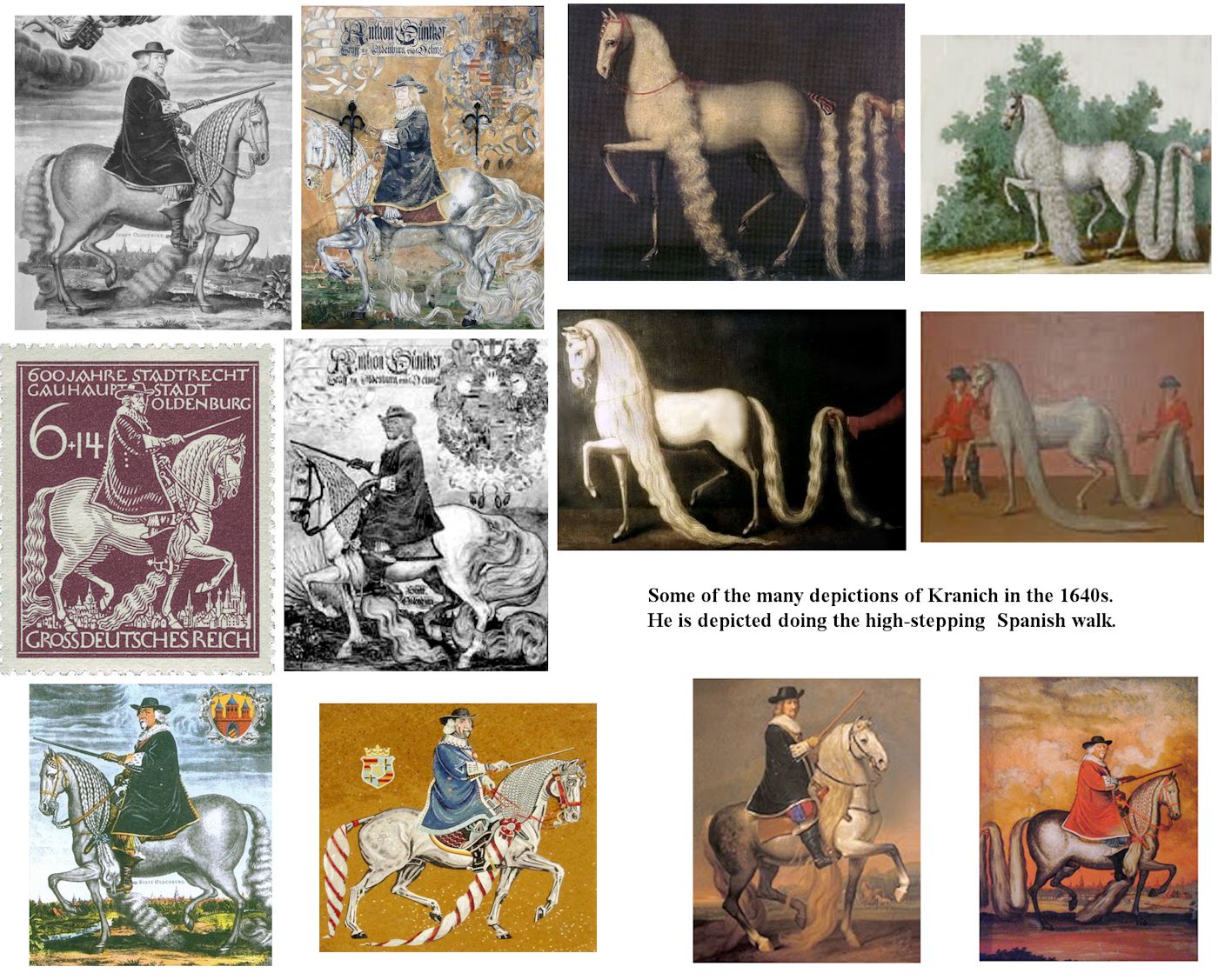
In modern times, some examples of the Florida Cracker Horse boast manes and tails that reach the ground and which may reflect Andalusian blood. Andalusians may also have manes and tails that reach the ground. Outside of travelling exhibits, such as the 19th Century menageries, circuses and sideshows that exhibited Linus and his ilk, such long hair is impractical.